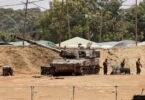Kyiv (BBC): Nato’s secretary-general says there is no sign of de-escalation by Russian forces on the ground near Ukraine.
Jens Stoltenberg said Russia still had a huge force ready to attack Ukraine. Russia says it is pulling back some of its troops and that military drills in Moscow-annexed Crimea have ended.
But Mr Stoltenberg warned the threat from Russia had become a “new normal” in European security. He said Nato was considering setting up new battle groups in central and SE Europe.
He said this was part of ongoing measures to bolster European defence – on which $270bn (£199bn) had been spent since 2014 – though he attempted to reassure Russia that Nato was not a threat.
France had offered to lead one such battle group in Romania, he said. Russia’s foreign ministry said it was “no longer interested” in Mr Stoltenberg’s statements.
Russia has more than 100,000 troops close to Ukraine but denies that it plans to invade.
The two countries have deep cultural and historic ties, and both were part of the former Soviet Union.
Russian President Vladimir Putin wants assurances that Ukraine will not join Nato because he sees any expansion of it as a threat. Nato has rejected that demand.
Mr Putin said on Tuesday that Russia did not want war, but demanded that the issue of Nato membership be addressed now, even though Ukraine is a long way from even starting an application to join the alliance. Mr Stoltenberg said Nato remained prepared for dialogue, and it was not too late for Russia to “step back from the brink of conflict”.
He expressed scepticism about Russian reports that some troops had been pulled back, after Russian statements and footage broadcast on Russian state television appeared to show military vehicles leaving Crimea. “We do not see any sign of de-escalation on the ground,” he said.
“This may of course change, but Russia maintains a massive invasion force ready to attack.”
He said Russia’s assertiveness was a new normal.
“Russia has demonstrated it is ready to contest fundamental principles of our security,” he said.
“They have used force to underpin and try to intimidate countries to accept its demands.”
Separately, Ukraine has been marking a so-called day of unity, with national blue and yellow flags raised throughout the country.
President Volodymyr Zelensky declared the day after US intelligence reports that Russia could attack Ukraine on Wednesday. On Tuesday the websites of Ukraine’s defence ministry, armed forces and two banks came under a cyber-attack.
The cause is not clear but Ukraine has suffered large-scale attacks before on its online infrastructure and has pointed the finger at Russia.
Russia’s government, however, has denied any involvement.
There has long been concern that, rather than a full-scale invasion, Russia could use less obvious means to destabilise Ukraine, for example through cyber-attacks on critical infrastructure.
Meanwhile, Ukraine staged military drills and defiant displays of flag-waving patriotism on Wednesday as NATO warned Russia is continuing to mass forces for a possible invasion.
Ukraine’s President Volodymyr Zelensky watched troops training with some of their new Western-supplied anti-tank weapons on a range near Rivne, west of the capital.
The demonstration of Ukrainian firepower contrasted with images on Russian state media that were said to show Moscow’s forces bringing an end to a major exercise in occupied Crimea.
In Rivne, a row of vehicles was destroyed by simultaneous missile test strikes and armoured vehicles manoeuvred and fired on the yellowing moorland, while in Kyiv hundreds of civilians marched in a stadium with an enormous national banner.
The “Day of Unity” displays came as the Kremlin called for “serious negotiations” with Washington, and European leaders pushed hard for a diplomatic resolution to the crisis.
NATO chief Jens Stoltenberg, hosting the alliance’s defence ministers in Brussels, dismissed suggestions that the threat on the border had diminished.
“It remains to be seen whether there is a Russian withdrawal,” he said.
“We are of course monitoring very closely what Russia does in and around Ukraine. What we see is that they have increased the number of troops and more troops are on their way.”






